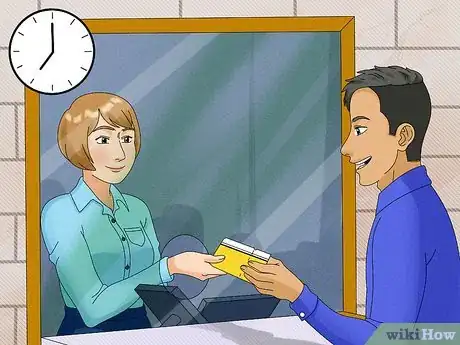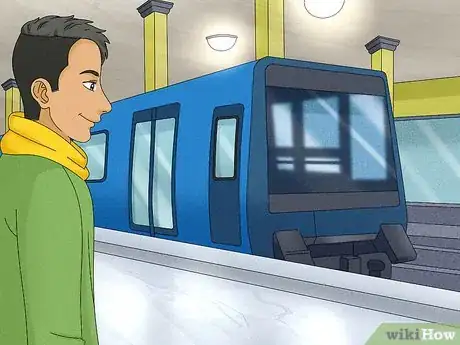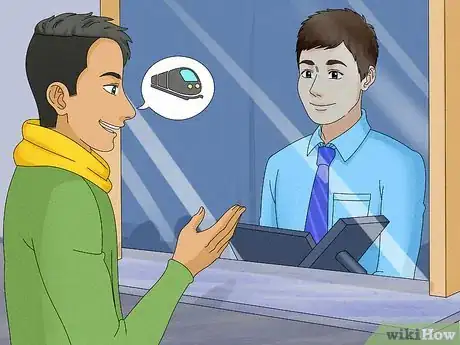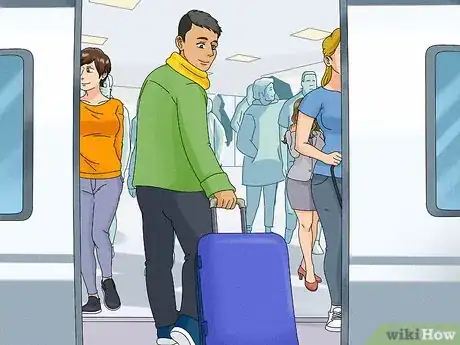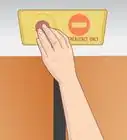X
wikiHow is a “wiki,” similar to Wikipedia, which means that many of our articles are co-written by multiple authors. To create this article, 27 people, some anonymous, worked to edit and improve it over time.
This article has been viewed 126,589 times.
Learn more...
Trains are a good way to get around both within cities and across country. Train stations are often well connected to bus or coach stations, and even airports allowing easy travel from A to B. If you've never travelled by train or haven't done so for a while, these steps provide some general guidance and advice.
Steps
-
1Plan! If you know the date and time of your journey two weeks or so in advance, go to a local station or onto a rail website and book your ticket early. This could save you money or get you a reserved seat on a busy service.[1]
- Pack all of your luggage so that you can easily have everything you'll need with you. Make sure that you can quickly pack the things that you might need to put in at the last available second.[2]
- Make sure to have a good breakfast, lunch or dinner before you start your journey. Not all trains have facilities to purchase food and drink.
-
2If you want to buy your ticket on the day of travel leave enough spare time to allow for queuing at the ticket office. Chances are you'll experience a horrible feeling of panic if you see your train about to leave and you haven't got your ticket![3]Advertisement
-
3Arrive early at your train's platform. Sometimes, the compartments are not sorted correctly and you might have to search for your train car. It is easier to do this from the platform than fighting through a crowded train.[4]
-
4Ask staff or look at the departure boards to see which platform your train will leave from. Follow signs to get to the platform and listen to the loudspeaker system for possible platform alterations. Bear in mind you might have to go up and down stairs, look for a lift if stairs aren't an option for you.
-
5Get on the train. Put your luggage in the overhead racks or designated luggage area rather than on the seat next to you as you may stop someone else sitting down. Just think how annoyed you'd be if you needed a seat and someone else was using up a perfectly good one for their bag or feet.[5]
-
6Relax.[6] Now you have your seat you are in a good place to forget about everything and just be transported to your destination. It is a good idea to pay attention to the announcements so you have an idea of how many stops there are until you get off or if you are approaching your destination. Don't worry too much about whereabouts you are as it is usually announced when your stop is coming up. If there are no announcements ask the conductor for the time when the train is expected to arrive.
-
7Get off the train.[7] If you have lots of luggage try to get it all together and stand near the door ready to get off the train. If you didn't hear the announcement ask someone nearby which stop you are approaching so you don't get off at the wrong place! Remember to press the buttons near the doors to open them. They won't open on their own.
-
8Look out for seats for disabled travellers. When a train is full people tend to sit in these seats. If a person who can't easily stand, or a pregnant person gets on, it is customary for those people in these seats to offer to get up.
Advertisement
Community Q&A
-
QuestionWhat do I do with my ticket once I have bought it?
 Community AnswerOn the train, someone will come and check everyone's tickets. Be sure to have the ticket ready!
Community AnswerOn the train, someone will come and check everyone's tickets. Be sure to have the ticket ready! -
QuestionIf you don't know where the platforms are at the train station, what should you do?
 Community AnswerDefinitely ask someone. This is better than losing your way looking yourself.
Community AnswerDefinitely ask someone. This is better than losing your way looking yourself. -
QuestionCan I board any train in general wagon with a ticket?
 Community AnswerFlexible tickets permit this. Others, such as Value or Saver, are valid only for the departure selected at booking. Eurostar Business Premier tickets of all booking codes also permit this freedom.
Community AnswerFlexible tickets permit this. Others, such as Value or Saver, are valid only for the departure selected at booking. Eurostar Business Premier tickets of all booking codes also permit this freedom.
Advertisement
Warnings
- Remember to allow a clear path off the train for those disembarking, and wait for all passengers to disembark before boarding the train.⧼thumbs_response⧽
- Make sure you purchase the correct type of ticket: Some tickets may only be valid at certain times of day, with specific train companies or they may even be limited to a specific train. As a general rule, the cheaper the ticket, the more restrictive it is.⧼thumbs_response⧽
- DO NOT attempt to board a train while the doors are closing - this may result in serious injury and/or delay the departure of the train .⧼thumbs_response⧽
- Have a look around for the emergency exits and so on just in case of an accident. Safety information is always useful to know when travelling by any means.⧼thumbs_response⧽
- Look out for penalty fares - these are in place at some staffed stations to penalize passengers for boarding a train without a ticket or with a ticket that is not valid for that particular journey. Penalty fares are only valid up to the first stop, and you are still required to purchase a ticket for the remainder of your journey.⧼thumbs_response⧽
- Always mind the gap between the train and the platform edge. Sometimes there can be a big gap so take care not to fall or drop anything onto the tracks.⧼thumbs_response⧽
- Be sure to take any personal belongings with you. It's hard to get back things that you leave on a train as it's difficult to discover where they have ended up. Try hard to be organised and not to forget your possessions! Do not leave your luggage unattended at any time.⧼thumbs_response⧽
Advertisement
Things You'll Need
- A train ticket
- Entertainment such as an MP3 player, magazine or book.
References
- ↑ http://blog.amtrak.com/2016/04/five-step-guide-to-planning-a-train-trip/
- ↑ https://www.frommers.com/slideshows/822168-how-to-pack-for-a-train-trip
- ↑ https://thesavvybackpacker.com/complete-guide-to-train-travel-in-europe/
- ↑ https://thesavvybackpacker.com/complete-guide-to-train-travel-in-europe/
- ↑ https://thesavvybackpacker.com/complete-guide-to-train-travel-in-europe/
- ↑ https://thesavvybackpacker.com/complete-guide-to-train-travel-in-europe/
- ↑ https://thesavvybackpacker.com/complete-guide-to-train-travel-in-europe/
- https://www.smartertravel.com/long-train-rides-what-to-pack/
About This Article
Advertisement

